Family : Solenostomidae

Text © Giuseppe Mazza

English translation by Mario Beltramini
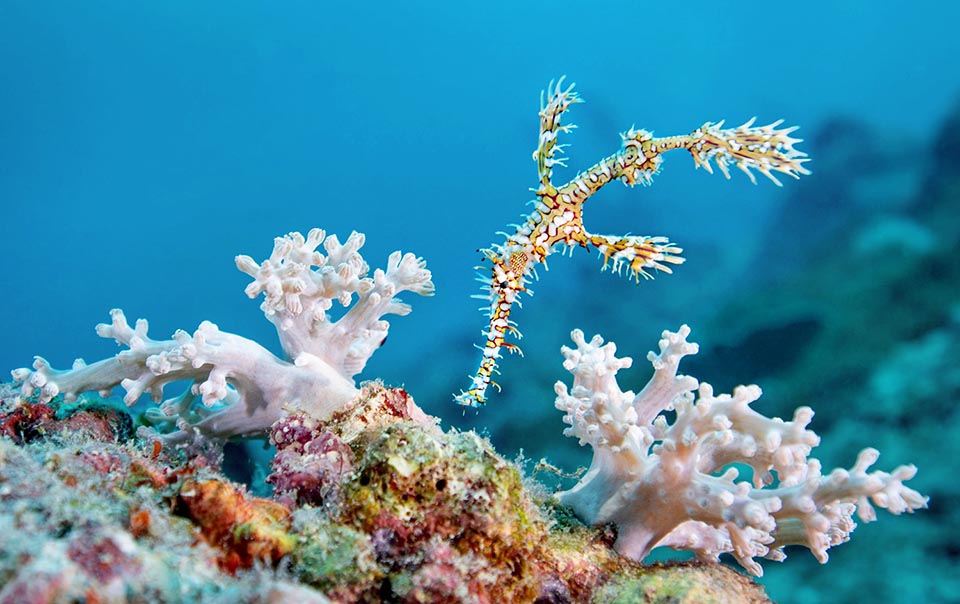
Bristly of spine-like mimetic shreds, the Harlequin ghost pipefish (Solenostomus paradoxus) lives in the western Indo Pacific warm waters © Grant Brodie
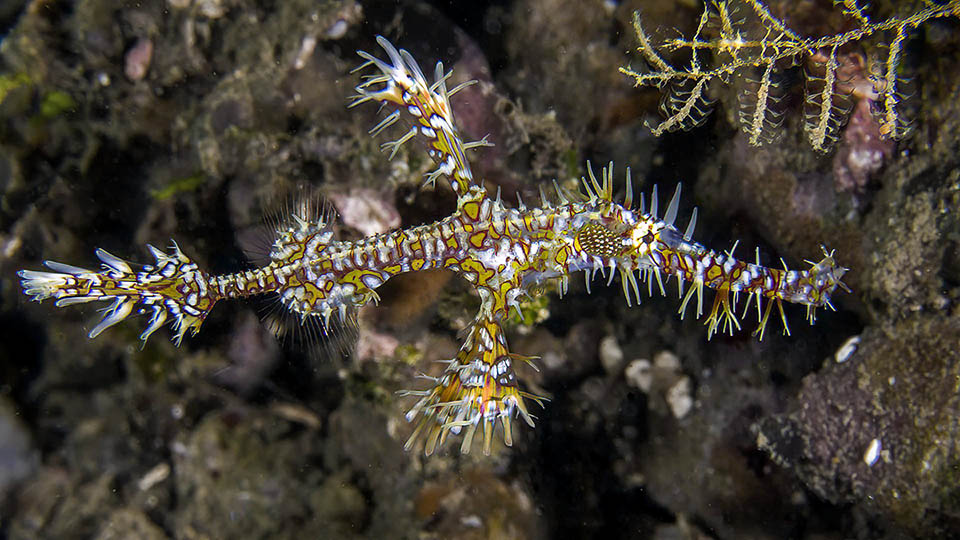
This male seems like the cross between a seahorse and a pipefish. In fact, there is a certain similarity, because both belong to the order of the Syngnathiformes © Ineke van Langeveld
The Harlequin ghost pipefish Solenostomus paradoxus (Pallade, 1770), belongs to the class of the Actinopterygii, the ray-finned fishes, and to the order of the Syngnathiformes that counts 5 families sharing the anatomy of the jaws, merged to form a sort of pipe.
They are the Aulostomidae, known as trumpetfishes; the Centriscidae, the famous razorfishes; the Fistulariidae, the cornetfishes; the Syngnathidae, that include the pipefishes and the seahorses; and the Solenostomidae, the ghost pipefishes having just only one genus, Solenostomus, and 5 species with intermediate characters between the seahorses and the pipefishes.
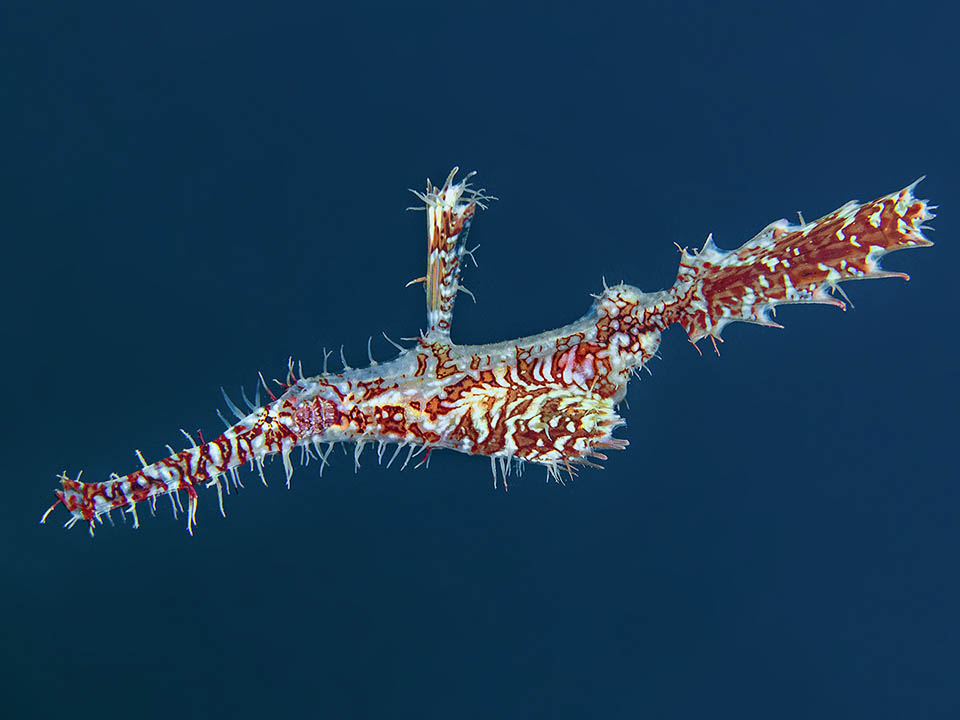
But whilst in seahorses and pipefishes the eggs are incubated by males, here they are protected by females in a ventral pouch born from the pelvic fins merging © Rafi Amar
The name of this genus, created by Lacépède in 1803, is born composed by the Greek “σωλήν” (solen) = groove, pipe and “στόμα” (stóma), because of its mouth shaped like a pipe of which we had previously mentioned, whilst the specific term paradoxus derived from the old Greek “παράδοξος” (paradoxos), paradox, refers in Latin to the unusual look of its body.
Zoogeography
Solenostomus paradoxus lives in the western Indopacific. It is present in the Red Sea, along the coasts of Tanzania and nearby Comoros and Mayotte Islands.
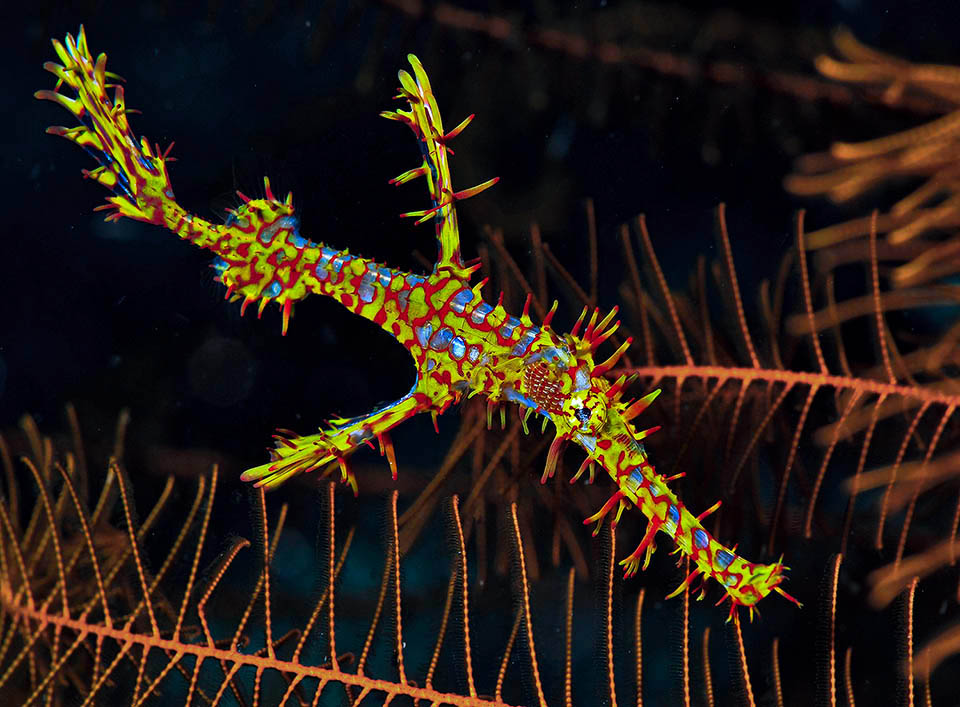
Livery is iridescent, often seeming like Harlequin dress. They don’t have scales. The body is protected by bony plates and the operculum seems a chessboard © Bernd Hoppe
Then we find it at Réunion, Mauritius, Maldives, Andaman Islands and in the waters of Malaysia, Indonesia, Timor-Leste, Papua New Guinea and Australia.
Northwards, after Palau and the Philippines, has colonized the coasts of Taiwan, China and Japan.
Moving eastwards, it is present in Micronesia, Solomon Islands, New Caledonia, Marshall Islands, Fiji Islands and Tonga where it has been discovered quite recently.
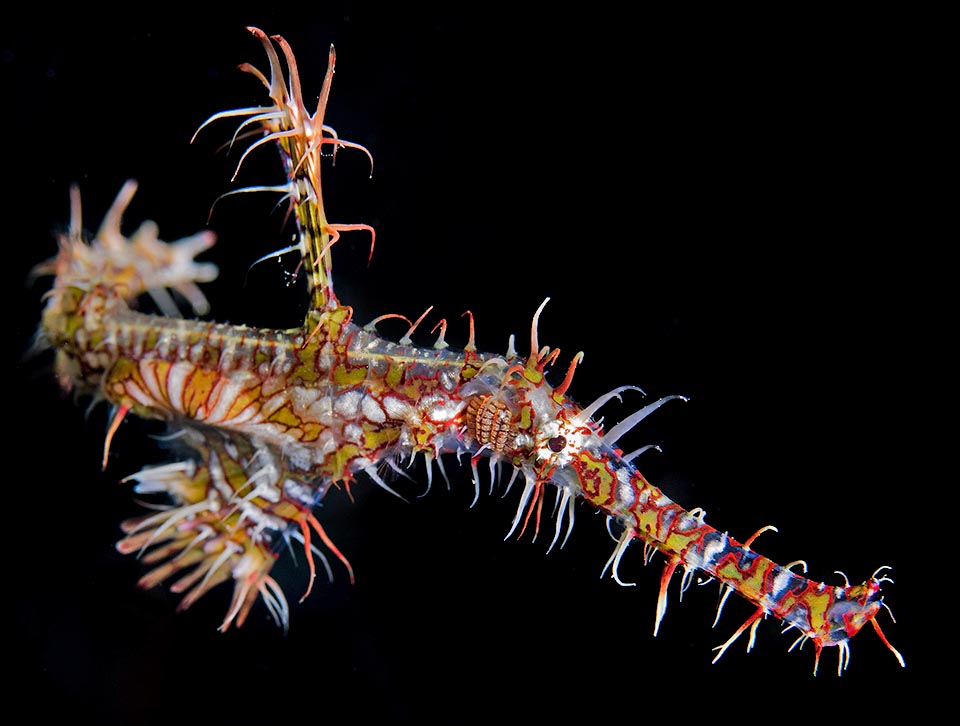
The eye of Solenostomus paradoxus is well hidden, camouflaged at the base of the long snout, and the mouth is armed by tiny teeth. They serve to hold the microscopic shrimps it eats, belonging often to the genus Mysida and to nibble the polyps, of the gorgonians and of the black corals, not to forget the long feathery arms of crinoids © Rafi Amar
Ecology-Habitat
Being unable to withstand the strong currents, the Harlequin ghostfish lives in the sheltered zones of the reefs where hunts in ambush, upside down like the Chinese trumpetfish (Aulostomus chinensis), almost invisible among the ramifications of gorgonians and black corals or the long feathery arms of the crinoids.
Conversely, it does not frequent the seagrass meadows, occupied by the other four congeners who have instead imitated hues and aspects of the green world.
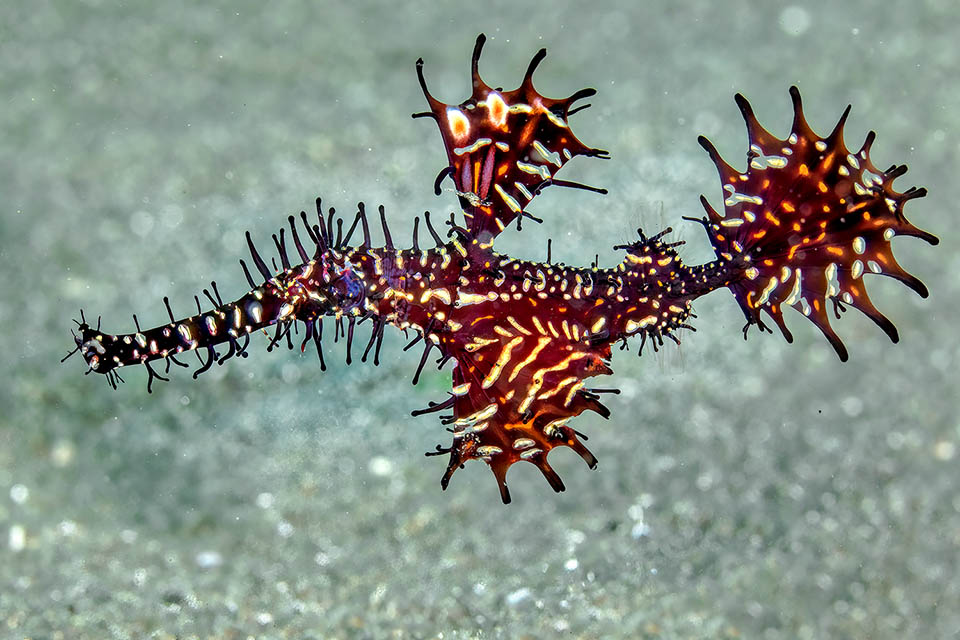
Swimming male. We see at once the ovaliform caudal and the first big dorsal fin like the pelvic ones. The second dorsal, the anal and the pectoral are small and transparent © Sonja Ooms
Morphophysiology
Solenostomus paradoxus can reach the length of 12 cm with females bigger than the males as this is a protandric hermaphrodite species with females that, when young, were males.
As it happens, in fact, in the Mediterranean to the Gilt-head bream (Sparus aurata) and to various inhabitants of the reefs like the famous Amphiprion ocellaris protagonist of the famous cartoon “Finding Nemo”, or the Rhinomuraena quaesita, are all fishes that upon the birth have already both sexes, but the male gonads mature before and only later the female ones will take the advantage.
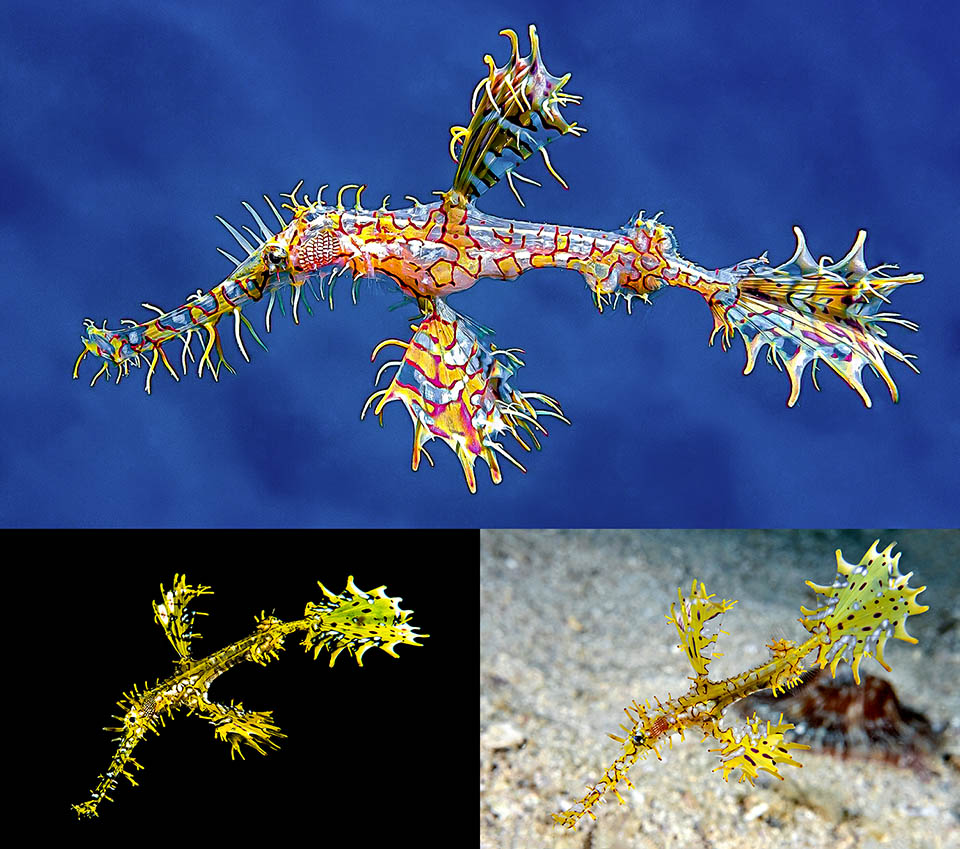
Incredible aspects of chromatic variability. The colours adapt to the environment and also the impudent yellow of the photo below can aver mimetic © Rudi Bloemmen (top) and © Rafi Amar (below)
The body of the Harlequin ghost pipefish does not have scales but is protected by 3-35 bony plates.
The head evokes a hippocampus with a long snout. The mouth has tiny teeth, proportionate to the size of the preys, mostly microscopic small shrimps like those belonging to the genus Mysida, but serve also for nibbling the polyps of the gorgonians and of the black corals or for consuming gradually the feathery arms of the crinoids.
There are two dorsal fins.
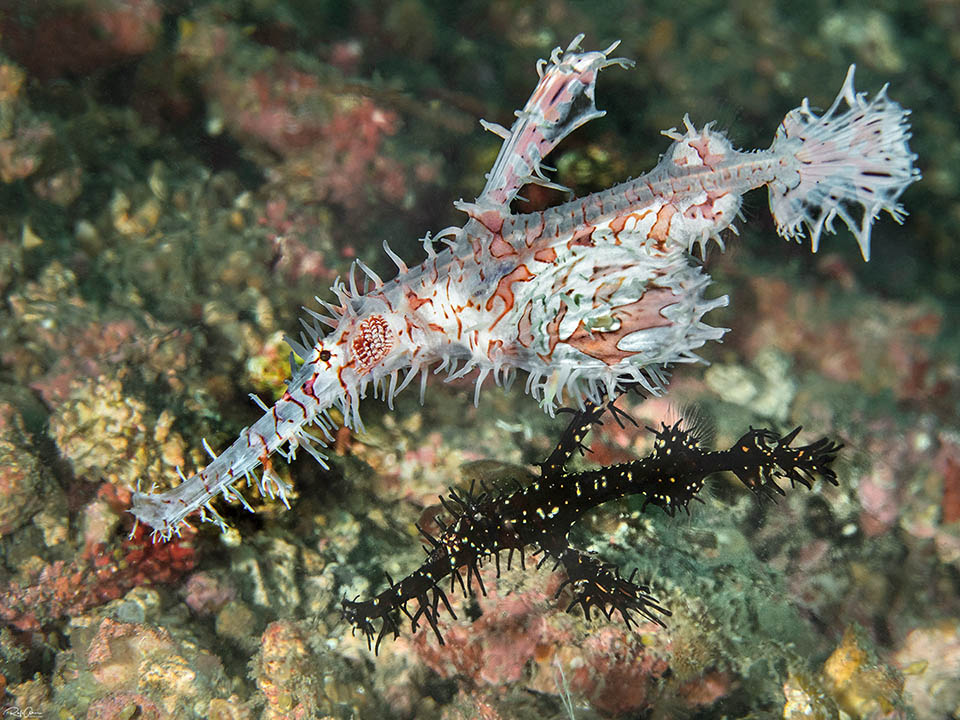
A couple. The female, maximum 12 cm long, has the ventral sac full of eggs. The black male below is always smaller because later, while growing, he becomes a female © Rafi Amar
The first, with 5 spiny rays, is relatively big, like the two pelvic fins present on the opposite side of the body. The second, with 17-21 unarmed rays, and the symmetrical anal fin are conversely small and transparent, almost invisible. To see them one must look at them carefully, just before the thin caudal peduncle, the tubercular enlargements of the body that support them.
Also pectoral fins are not noticed at first sight, as they are small and transparent with 25-28 soft rays.
The caudal fin, ovaliform, often folded like a fan, is toothed and has, like all the body, mimetic skin shreds similar to spines.
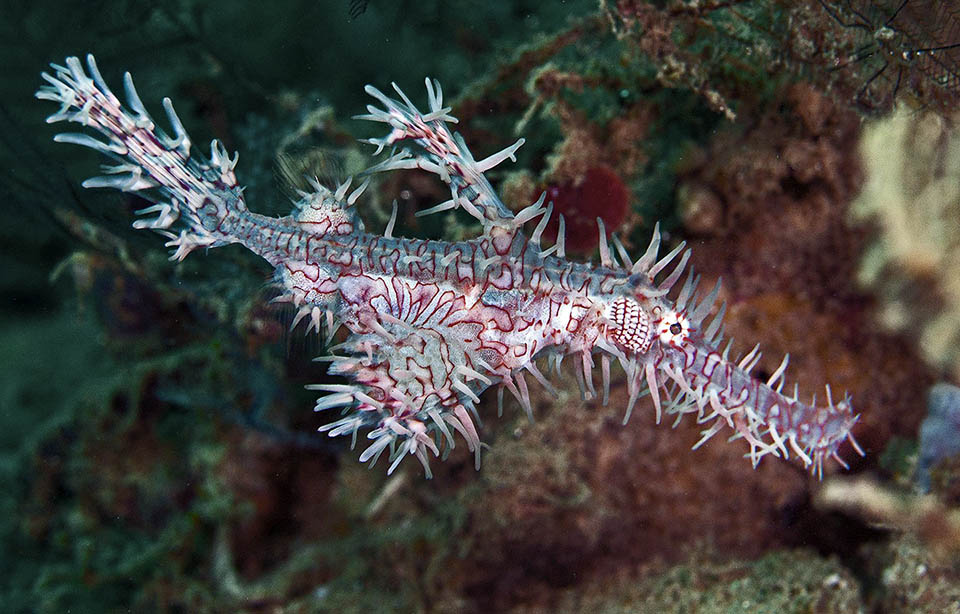
Ventral sac may contain 350 eggs less than 1 mm broad. They hatch after about 3 weeks and the newborns are expelled a little at a time with the respiratory contractions © Ineke van Langeveld
The operculum, close to the eye, has the unusual drawing of a chessboard.
The livery, partly translucent or white, is extremely variable. The predominant colours are the yellow, the orange, the red and the black with intermediate dyes such as the pink, the violet, the blue and the brown in imaginative combinations worthy of the Harlequin dress, as various vulgar names recall: Poisson-fantôme arlequin in French, Harlekin Geisterpfeifenfisch in German and Harlekijn spookfluitvis in Dutch.
In the females the ventral fins merge to form, stuck to the body, an incubating pouch for the eggs.
The young are almost transparent with the rays of the first dorsal fin, the pelvic and the caudal ones particularly long.
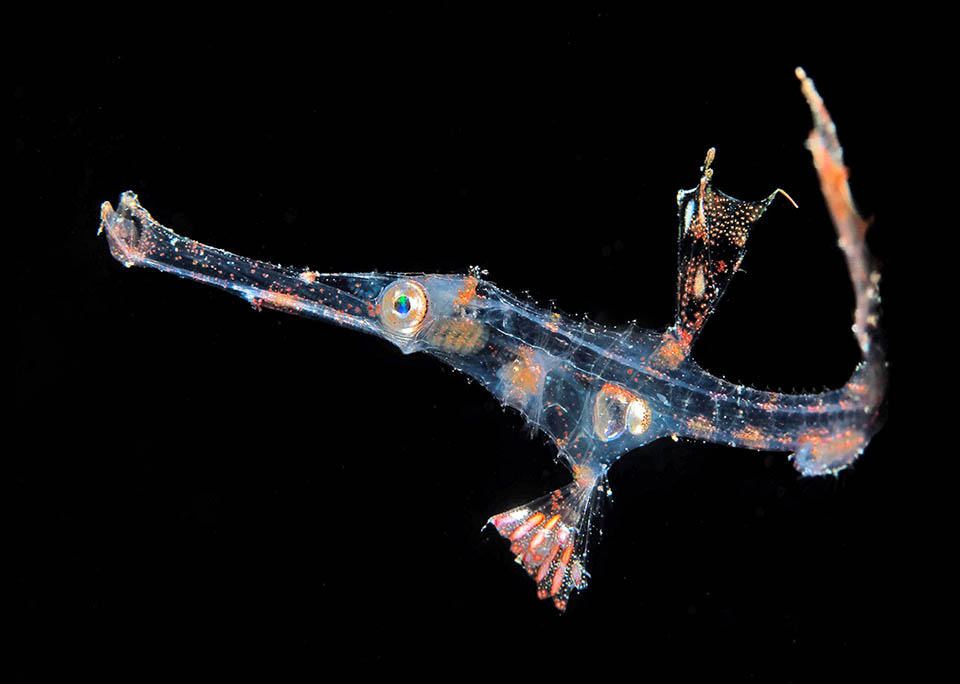
During the long larval period the young are practically transparent and they go drifting nourishing of plankton © Rafi Amar
Ethology-Reproductive Biology
Solenostomus paradoxus usually goes swimming solitary or in couples. Its biology is still little known but it looks like it lives about one year with a very long larval and juvenile status. Practically, the adults should have then just the time to reproduce only once before passing away.
Unlike the seahorses and the pipefishes that entrust their eggs to the marsupium of the male, here, after the fecundation, they are stuck on the inner side of the pelvic fins of the females in their ventral pouch.
It may contain 350 eggs, less than 1 mm wide, that hatch after about 3 weeks. The newborns are expelled a little at a time with the respiratory contractions, as happens with the males of the seahorses.
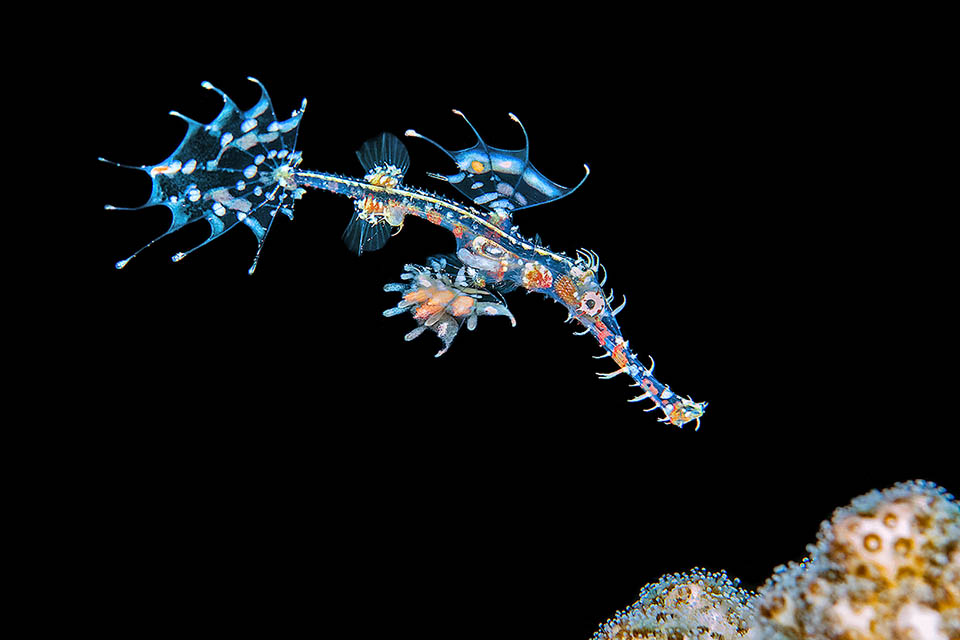
This stage ends when they reach the size of the adult males. The rays of the first dorsal fin and of the caudal one are proportionally much longer © Rafi Amar
Despite its unusual beauty, the Harlequin ghost pipefish is obviously unsuitable for aquarium life and presently (2022) even the climate changes should not hit it too much, considering its multiple food options.
Luckily, the man does not pursue it and, also considering its vast range, this species has a very low vulnerability index, almost a record in the world of fishes as it marks only 10 on a scale of 100.
Synonyms
Fistularia paradoxa Pallas, 1770; Solenostomatichthys paradoxus (Pallas, 1770).
→ For general information about FISH please click here.
→ For general information about BONY FISH please click here
→ For general information about CARTILAGINOUS FISH please click here.
→ To appreciate the BIODIVERSITY of BONY FISH please click here.
→ To appreciate the BIODIVERSITY of CARTILAGINOUS FISH please click here.
